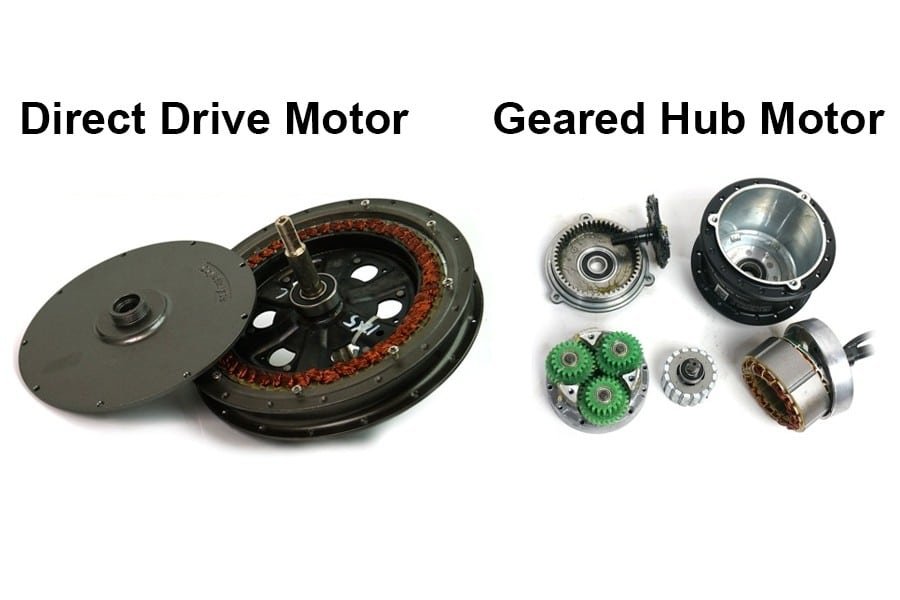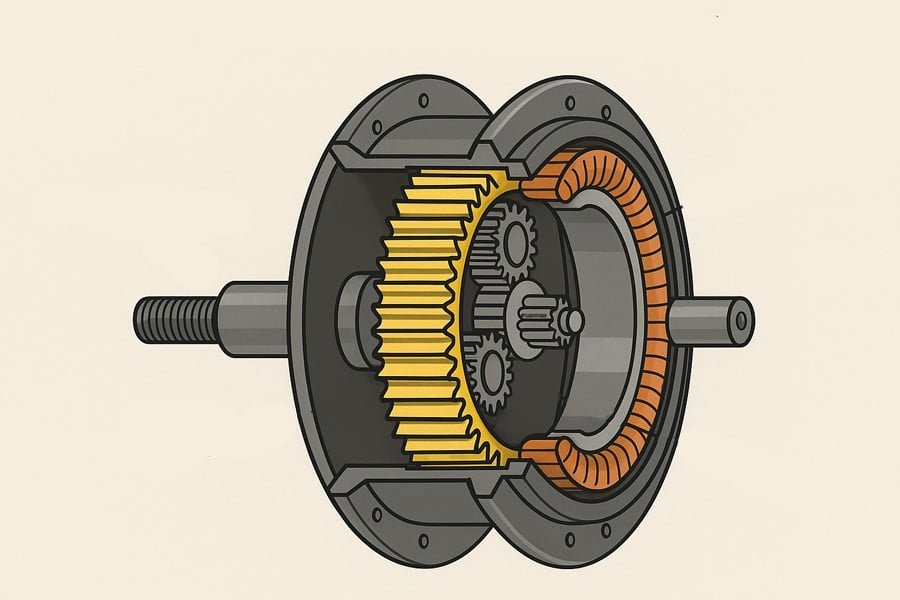A Regen, sappiamo che scegliere il motore giusto non è solo una decisione tecnica, ma strategica. Per i marchi, i rivenditori e gli ingegneri del settore delle e-bike, soprattutto nel Mercato europeo delle bici da carico, comprendere i tipi di motore è fondamentale per garantire prestazioni, affidabilità e soddisfazione del cliente.
Abbiamo supportato innumerevoli clienti nell'ottimizzazione dei loro sistemi di alimentazione per biciclette da carico elettriche, aiutandoli a orientarsi tra i pro e i contro di trasmissione diretta E motori a mozzo con ingranaggiQuesta guida condivide le nostre intuizioni, basate su progetti reali, non solo sulla teoria.
1. Introduzione: perché la scelta del motore è importante
Nel crescente mondo delle bici elettriche, la scelta del motore può definire il successo del tuo prodotto. Per biciclette da carico, dove carico, terreno ed efficienza sono più che mai importanti, un motore sbagliato può portare a scarse capacità di salita, autonomia limitata o peso non necessario.
Noi di Regen siamo specializzati nella personalizzazione di soluzioni motoristiche per i marchi europei. Abbiamo visto in prima persona come comprendere la differenza tra motori a mozzo con ingranaggi E motori a trasmissione diretta porta a progetti migliori, clienti più soddisfatti e un posizionamento più forte sul mercato.
Questo articolo riguarda principalmente i motori con mozzo riduttore e i motori a trasmissione diretta. Se siete interessati, potete leggere l'articolo precedente:
Panoramica tecnica
Come funzionano i motori con mozzo ingranato
UN motore del mozzo con ingranaggi integra un set di ingranaggi planetari all'interno del carter del mozzo. Il motore stesso funziona ad alti giri al minuto (RPM), ma attraverso il sistema di riduzione degli ingranaggi, questa velocità viene convertita in una velocità della ruota inferiore e più utilizzabile, aumentando al contempo significativamente la coppia erogata. Questo design consente a motori più piccoli e leggeri di erogare una potenza sufficiente, soprattutto per applicazioni che richiedono frequenti avviamenti, arresti e capacità di superare salite.
Questi motori pesano in genere tra da 2 a 4 kg, rendendoli compatti e facili da integrare in vari modelli di bici senza influire significativamente sul peso totale. L'inclusione di un meccanismo a ruota libera significa anche che quando il motore non è in uso, i ciclisti possono pedalare senza resistenza.
Come funzionano i motori del mozzo a trasmissione diretta
Al contrario, un motore del mozzo a trasmissione diretta Elimina completamente gli ingranaggi interni. Lo statore del motore è fissato all'asse, mentre il guscio esterno, dotato di magneti permanenti, ruota direttamente con la ruota. La potenza viene erogata tramite forza elettromagnetica, garantendo un funzionamento fluido e silenzioso.
Tuttavia, questa semplicità ha un costo in termini di dimensioni e peso. I motori a trasmissione diretta pesano generalmente tra da 4 a 9 kg, con diametri spesso superiori 20 centimetriPoiché questi motori devono ruotare alla stessa velocità della ruota, sono intrinsecamente meno efficienti a basse velocità, ma eccellono nel mantenere una velocità di crociera elevata.

Pro e contro: confronto Tra motori con mozzo ingranato e mozzo a trasmissione diretta
Presso Regen valutiamo i tipi di motore non solo in base ai vantaggi generici, ma anche in base alle loro prestazioni rispetto a parametri tecnici critici quali coppia in uscita, efficienza energetica, durata e integrazione del sistema.
Motori con mozzo ingranato
Vantaggi:
- Elevata coppia in uscita: Ideale per le salite, il trasporto di carichi pesanti e le frequenti fermate e partenze tipiche della logistica urbana.
- Leggero e compatto: Supporta una migliore maneggevolezza e si conforma facilmente alle normative sensibili al peso come EN 15194.
- Funzionalità ruota libera: Consente una pedalata fluida senza resistenza del motore quando non è alimentato.
- Efficienza energetica a velocità basse e medie: Ottimizzato per percorsi urbani e per le consegne.
- Produzione conveniente: I costi di produzione più bassi si traducono in prezzi competitivi per OEM e ODM.
Svantaggi:
- Usura meccanica: Gli ingranaggi interni sono soggetti ad usura nel tempo, in genere dopo da 10.000 a 15.000 km, a seconda del carico e del terreno.
- Rumore operativo: Sebbene i materiali moderni e la progettazione degli ingranaggi elicoidali abbiano ridotto i livelli di rumore, questi rimangono comunque più elevati rispetto ai sistemi senza ingranaggi.
- Nessuna frenata terapeutica 1TP2: Il meccanismo a ruota libera impedisce il recupero di energia durante la frenata.
Motori del mozzo a trasmissione diretta
Vantaggi:
- Funzionamento silenzioso: L'assenza di punti di contatto meccanico garantisce prestazioni pressoché silenziose, migliorando il comfort del pilota.
- Capacità di frenata terapeutica 1TP2: Converte l'energia cinetica in energia della batteria, utile nelle lunghe discese e per ridurre l'usura dei freni.
- Durata: Un minor numero di parti mobili porta a minori tassi di guasti meccanici nel tempo.
- Efficienza stabile ad alta velocità: Offre le massime prestazioni a velocità elevate costanti, il che lo rende adatto alle bici elettriche veloci e al trasporto interurbano.
Svantaggi:
- Pesante e ingombrante: Aggiunge un peso significativo, che può influire negativamente sulla maneggevolezza, soprattutto nel caso delle bici da carico.
- Bassa coppia all'avvio: Scarse prestazioni in ambienti ripidi o con frequenti arresti e partenze senza design sovradimensionati.
- Resistenza magnetica: L'assenza della ruota libera rende più difficoltosa la pedalata senza assistenza.
- Minore efficienza in condizioni urbane: Maggiore consumo energetico durante le operazioni a bassa velocità e le frequenti accelerazioni.
Approfondimenti sulle applicazioni da Regen
Grazie alla vasta esperienza di progetto in diversi mercati, Regen ha sviluppato un approccio strutturato alla selezione del motore, in particolare per biciclette elettriche da carico, dove le esigenze operative variano notevolmente a seconda della geografia, del carico utile e dei modelli di utilizzo.
Selezione del motore in base al caso d'uso
- Biciclette da carico urbane: Per le biciclette per le consegne in città che affrontano frequenti fermate, traffico e pendenze, consigliamo costantemente motori a mozzo con ingranaggiLa coppia elevata e il design leggero li rendono ideali per muoversi in ambienti urbani densi, massimizzando al contempo l'efficienza della batteria.
- Trasporto merci a lunga distanza: Laddove i percorsi prevedono terreno pianeggiante e velocità di crociera prolungate, motori a trasmissione diretta diventare un'opzione praticabile. In questi casi, la frenata rigenerativa può offrire un incremento di efficienza, soprattutto su percorsi con lunghi tratti in discesa.
- Applicazioni su terreni misti: Nelle regioni con terreno variabile, il nostro approccio spesso prevede simulazioni avanzate di coppia e analisi del carico per determinare se sistemi di ingranaggi migliorati o soluzioni ibride offrano prestazioni migliori.
Riferimenti
- Biciclette Espin. (2022). Motori nel mozzo con ingranaggi o a trasmissione diretta: qual è il migliore? Recuperato da https://www.espinbikes.com
- Ebikes.ca. (2024). Capire la frenata terapeutica 1TP2 nelle bici elettriche. Recuperato da https://www.ebikes.ca
- MacArthur, J., Harpool, M. e Scheppke, D. (2021). Il potenziale delle bici elettriche: progressi nella tecnologia delle biciclette elettricheCentro di ricerca e formazione sui trasporti (TREC). https://doi.org/10.15760/trec.274
- Bafang. (2023). Libro bianco sulla tecnologia dei motoriRecuperato da https://www.bafang-e.com
- Mahle. (2024). Sistema X20: la prossima generazione di motori leggeri per bici elettriche. Recuperato da https://mahle-smartbike.com
- Neodrive. (2023). Soluzioni efficienti di trasmissione diretta per bici elettriche. Recuperato da https://www.neodrives.com
- Comitato europeo di normazione. (2023). EN 15194: Biciclette a pedalata assistita elettricamente – Biciclette EPAC.
Dichiarazione di limitazione della responsabilità sul copyright delle immagini
Alcune immagini utilizzate in questo sito web/articolo provengono da internet e sono destinate esclusivamente a scopo illustrativo e didattico per migliorare la comprensione dei contenuti. Rispettiamo i diritti di proprietà intellettuale degli autori originali e ci impegniamo a citare le fonti ove applicabile.
Se sei il legittimo proprietario di un'immagine qui visualizzata e ritieni che il suo utilizzo costituisca una violazione del copyright, ti preghiamo di contattarci all'indirizzo info@regencargobikes.comDopo la verifica, rimuoveremo tempestivamente l'immagine o forniremo la relativa attribuzione.
Grazie per la comprensione.
© Regen Technology Co., Ltd.






